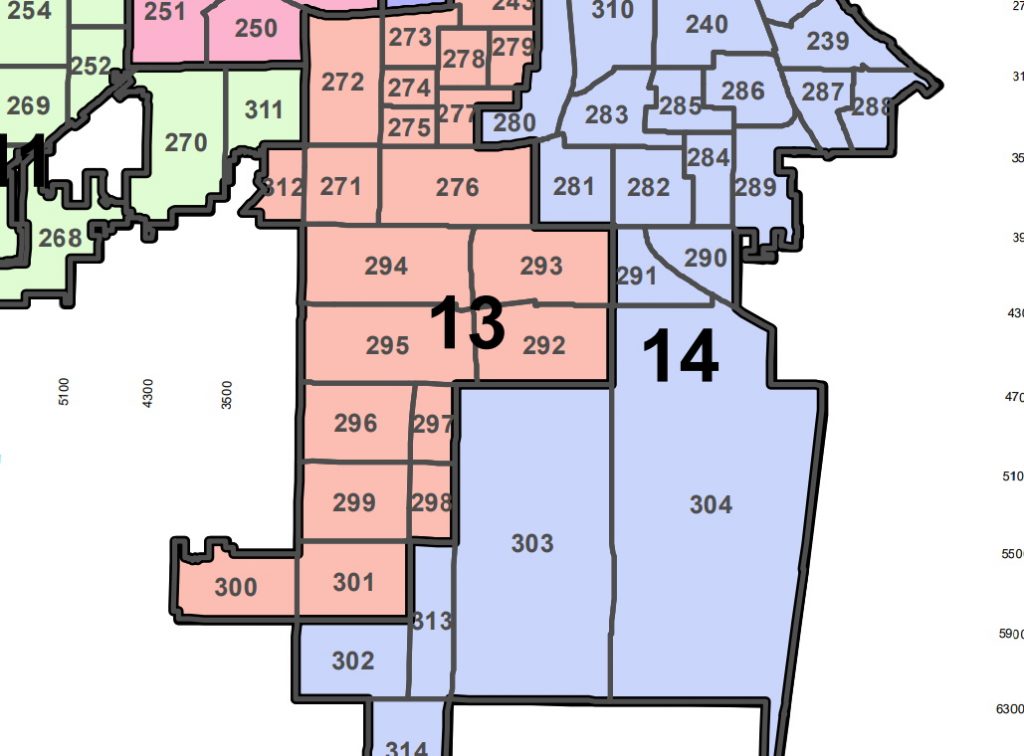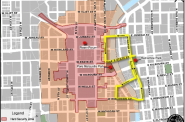Milwaukee Starts Over On Redistricting, Only To Adopt Same Map Again
Effort to expand Latino influence won't stand up to legal challenges says City Attorney. Alderwoman says council "hoodwinked" and "railroaded."
Milwaukee’s second attempt at redrawing its 15 council districts took an unexpected twist Monday.
In November the Common Council thought it had concluded its decennial redistricting process. Making relative minor adjustments to accommodate areas of the city where the population grew or shrank, it adopted a new map that maintained the balance of six Black majority districts, two Hispanic districts and five white districts. Two of the white districts were defined as Hispanic “influence” districts with a Hispanic voting-age population of at least 25%. The remaining two districts had no racial or ethnic majority.
After a six-hour meeting Monday, the council’s Judiciary & Legislation Committee ended up adopting its original map again.
“We have received some advice that was surprising to some members,” said Alderman Robert Bauman after the committee emerged from a three-hour, closed-session discussion with the City Attorney’s Office.
At its simplest level, the City Attorney’s Office doesn’t believe any of the council’s revised maps would survive an equal protection challenge in court. The council and community members’ explicit rationale for considering changes was race and, under the legal standard of strict scrutiny, the council could only consider race if it was correcting a federal Voting Rights Act violation. The City Attorney’s Office believes no such violation exists with the earlier map, but did previously provide Barrett advice on the legality of vetoing it and extending the process.
The committee unanimously endorsed reapproving the original map. The full council will meet to consider it on Jan. 18.
After the meeting, Voces executive director Christine Neumann-Ortiz called the committee’s actions a “disgrace” and “disappointing.” She said her organization is looking for its own legal opinion and considering further actions.
“We think there is a possibility that there is a voting rights violation,” said Voces redistriction commission member and attorney Richard Saks. “That’s something we’re going to explore.”
“Tonight the City of Milwaukee failed all of its immigrant and refugee communities as they were left with less tonight than when the day began,” said Alderwoman JoCasta Zamarripa in a press release after the committee voted. “The largest city in the state has failed its people because of poor advice from the Office of the City Attorney. Members of the Judiciary and Legislation Committee, elected representatives of Milwaukee’s Latino community, and community advocates were hoodwinked.”
And despite the fact that the council appears poised to end up where it started, many new maps were floated, and a lot of conflicting opinions about them were offered. Maps were submitted by Voces, Forward Latino, Milwaukee Muslim’s community, District 13 Alderman Scott Spiker and District 14 Alderwoman Marina Dimitrijevic.
Six different maps were discussed, each of which is centered on moving the dividing line between the two proposed Hispanic influence districts: District 13 (the far south side Garden District) and District 14 (Bay View and a handful of surrounding neighborhoods). By trading previously-approved wards back and forth, the four maps fully evaluated by city staff would have pushed the Hispanic voting-age population as high as 41.4% in District 13 and as low as 14.1% in District 14. The previously approved map had them at 25.6% and 28.1% respectively.
“If Latinos are 20% of the population that means they should be entitled to three aldermanic representatives,” said Neumann-Ortiz. She said Spiker, who has touted the diversity of his district, was attempting to maintain a district controlled by white conservatives. Spiker has previously said he thought his district could become majority Hispanic in the next decade without changing its boundaries.
“We created the compromise map, which is now known as B,” said Forward Latino head Darryl Morin during the meeting. It increased the Hispanic population in the 13th at the expense of the 14th.
But Map B, and every other map offered, exposed another potential issue: another racial minority that would be impacted.
Centered around the Islamic Society of Milwaukee, 4704 S. 13th St., a growing Muslim community fills District 13. “The Muslim community very much lives in a circle around that,” said Palestinian immigrant and real estate developer Nabil Salous.
Though it was referred to by many speakers as a Muslim community, it isn’t eligible for protection under the Voting Rights Act because of its religious status, but instead its racial makeup. The population is made up of a number of minority groups, best summarized as MENA (Middle East and North Africa). It also includes a growing Indian subcontinent population. The census, originally proposed by the Obama administration to include a MENA identity option, ultimately was conducted without the option under the Trump administration. The result is that there is no clear data on exactly how many area residents are part of the minority population base, but looking at area business names leaves an unmistakable impression that it’s a sizable population.
“This map would split the Muslim community very much in half,” said Salous, singling out Map B. It would do so by splitting at W. Layton Ave. “The Muslim community vote will be diluted or canceled.”
Spiker, who had noted the challenge in the first go-round, highlighted the competing interests again on Monday. “This is the sorest point for me,” said Spiker of trying to not split up the emerging Muslim community. But he was also critical of the potential for disruption from other configurations as well, either from voter turnout disparities or substantially reconfiguring the area around the airport. “It’s not a pretty spot to be in, but it’s the spot we’re in.”
Ald. Michael Murphy, after more than a dozen community members spoke, asked Assistant City Attorney Kathryn Block if she was comfortable that the only reason discussed for making a change was race.
After explaining the framework under which race could be used to correct a Voting Rights Act violation, Block advised: “probably that’s something we should discuss in closed session.” She noted that the original map, according to City Attorney’s Office, did not have a Voting Rights Act violation.
“If there’s no voting rights violation, it sounds like we might have an issue,” said Bauman. “Houston, sounds like we have a problem.”
“I knew nothing about this,” said Zamarripa, before the committee went into closed session. “I’m offended by this last-ditch effort by the alderman of the 13th that just doesn’t want to look at any amount of change.”
An eight-page opinion, signed by City Attorney Tearman Spencer, addressed to Spiker and dated Jan. 9, is attached to the council file and warns of potential challenges.
“This was not of my creation, this was out of a conversation with the Muslim community,” said Spiker. “The worst thing that could happen is that we pass something that is illegal. We don’t want to do that.” He brought up scenarios where adopting either map would result in a lawsuit from one of the affected groups.
The new map would first be used for the 2024 council election.
Maps and Statistics
- Map E
- Map D
- Map C
- Map B
- Maps B, C, D and E Descriptions
- Barrett Veto Letter
- Voces-Petering Map Options
- Voces Original Concept Map
- Adopted District Map – Detailed
- Adopted District Map – 11×17
- Adopted District Map Demographics
- Adopted 2021 City Ward Map
- 2012 Ward Map
- 2012 Common Council Districts
- 2000 to 2010 Population Change by Aldermanic District
- 2010 to 2020 Population Change by Aldermanic District
- 2020 Population Change by Wards
- 2020 Aldermanic District Demographics
If you think stories like this are important, become a member of Urban Milwaukee and help support real, independent journalism. Plus you get some cool added benefits.
More about the Milwaukee County redistricting process
- Op Ed: Muslim Community Needs Representation - Janan Najeeb - Jan 29th, 2022
- City Hall: Council Ends Redistricting With Anger, Tears - Jeramey Jannene - Jan 18th, 2022
- Statement from Milwaukee Mayor Cavalier Johnson - Mayor Cavalier Johnson - Jan 18th, 2022
- City Hall: Latino Leaders Could Sue Over Redistricting - Jeramey Jannene - Jan 14th, 2022
- Latinx Leaders Condemn Common Council’s Refusal to Draw New Districts Reflecting Dramatic Growth of Latinx Population; Demand Second Legal Opinion - Voces de la Frontera - Jan 14th, 2022
- Voces de la Frontera Statement on Redistricting Decision - Voces de la Frontera - Jan 11th, 2022
- Statement on redistricting decision - Ald. JoCasta Zamarripa - Jan 10th, 2022
- City Hall: Milwaukee Starts Over On Redistricting, Only To Adopt Same Map Again - Jeramey Jannene - Jan 10th, 2022
- Statement by Milwaukee Mayor Tom Barrett: - Mayor Tom Barrett - Dec 14th, 2021
- City Hall: Council Halts Redistricting After Latino Pushback - Jeramey Jannene - Dec 14th, 2021
Read more about Milwaukee County redistricting process here
Political Contributions Tracker
Displaying political contributions between people mentioned in this story. Learn more.
- October 30, 2019 - JoCasta Zamarripa received $100 from Darryl Morin
- June 30, 2019 - JoCasta Zamarripa received $200 from Darryl Morin
- May 29, 2019 - JoCasta Zamarripa received $250 from Darryl Morin
- August 29, 2015 - Tom Barrett received $100 from Nabil Salous























If the politicos are truly interested in Milwaukee citizens’ voices being heard, they should put this energy toward improving voter turnout rates – which range from abysmal to fair depending on the election and district. This redistricting brouhaha seems mostly about the players’ self interests.